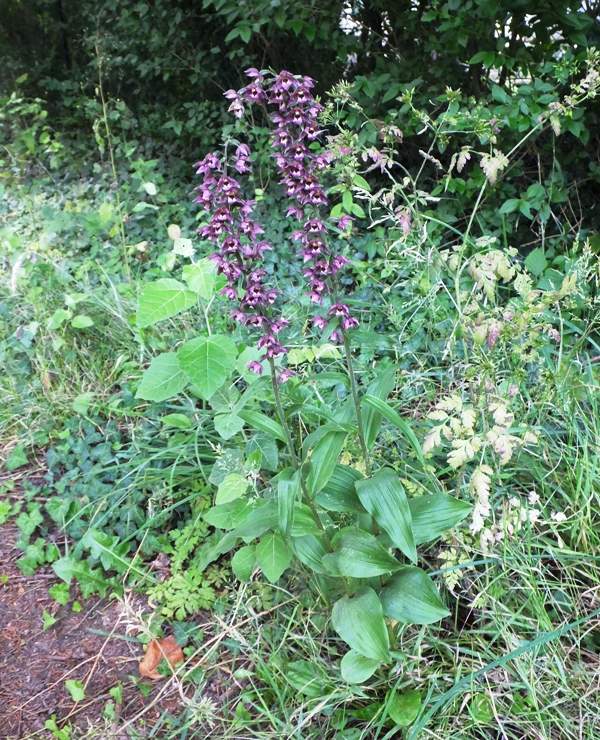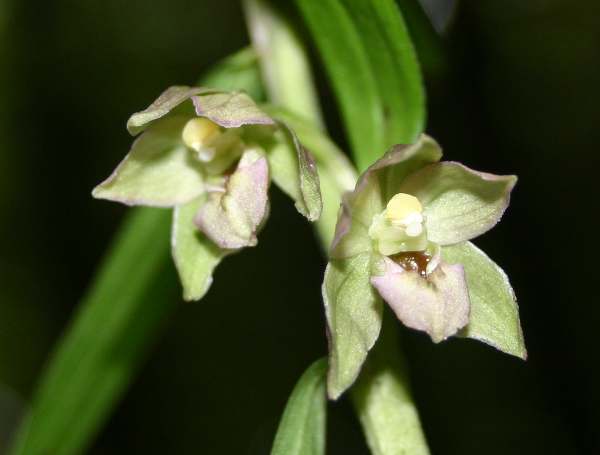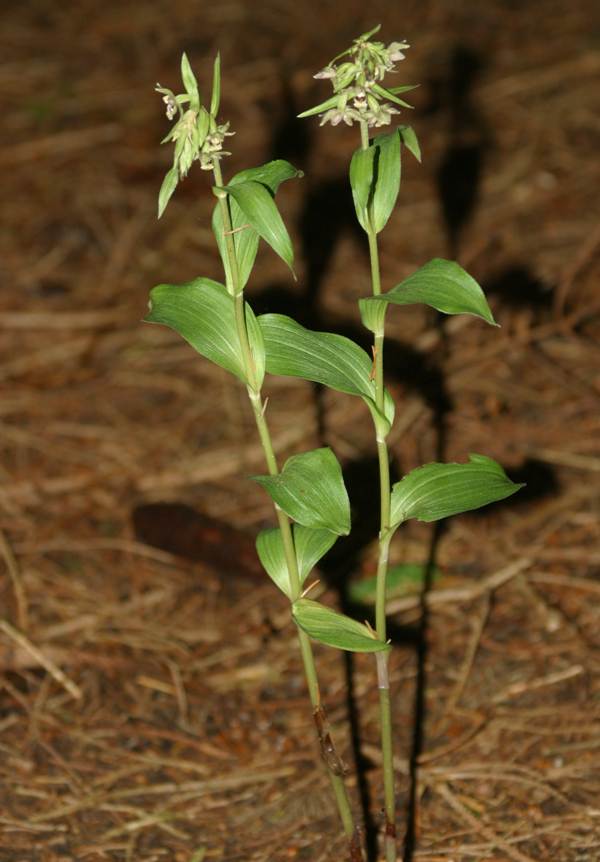Epipactis helleborine - Broad-leaved Helleborine
Phylum: Magnoliophyta - Class: Liliopsida - Order: Orchidales - Family: Orchidaceae

Anyone fond of walking in woods and forests in high summer might come across the Broad-leaved Helleborine, which grows in clearings and often appears very close to well trodden paths. Coniferous woodland is particularly good for Epipactis helleborine, but these stately orchids are also found in or on the edges of broadleaf woodland, particularly under Quercus (oak) species.
Description
Accurate identification of Epipactis helleborine is difficult throughout its territorial range because it is extremely variable both in its overall size and the colouring of its flowers.
Depending on their position, the plants of Broad-leaved Helleborine can grow to close on a metre in height, but in more exposed positions the plants are often small and spindly. The leaves, which are large and usually veined, are the most obvious distinguishing feature of the species. The flowers are sometimes green but more often green washed with pink or purple. Some plants have deep pink flowers and this often leads to confusion with Dark-red Helleborine Epipactis atrorubens, but the two species grow in very different habitats.
Distribution
Widespread throughout Britain and Ireland. This orchid also occurs in most of mainland Europe, although some plants found in the Mediterranean region are treated as separate species. The range continues throughout central Asia and into the Himalayas. Epipactis helleborine was imported to North America and is spreading through many states.

Habitat
Epipactis helleborine is essentially a woodland plant and, although mainly associated with deciduous trees, in Wales it is found extensively with spruce trees. Although it prefers open rides and the sides of paths where there is more light, in some places this orchid grows very successfully in deeply shaded woodland.

Flowering times
Broad-leaved Helleborine flowers from late June through to early September.
The specimens on this page were photographed in dark coniferous woodland in Southwest Wales during August.
Epipactis helleborine f. alba - Broad-leaved Helleborine - white form
From time to time specimens of Epipactis helleborine with white leaves are found, and are described as being a 'white form' of the species - see below.


Epipactis helleborine f. alba. Pictures: Simon Harding
Subspecies, Hybrids and Varieties
Subspecies:
Epipactis helleborine subsp. neerlandica (Dutch Helleborine) is a shorter and more robust plant with a dense spike of dark-pink flowers; it was thought to grow in the dune slacks of South Wales, but genetic studies have revealed that there is very little difference between those plants and other Broad-leaved Helleborines.
Varieties:
Epipactis helleborine var. monotropoides lacks chlorophyll and is very pale; it is sometimes referred to as Epipactis helleborine var. albiflora.
Epipactis helleborine var. viridiflora lacks anthocyanins and has very pale green flowers with whitish lips; it is rare.
Epipactis helleborine var. purpureais rare and has dark-pink to red flowers.
Young's Helleborine Epipactis youngiana was thought to differ from Broad-leaved Helleborine for a number of reasons including a difference in biological reproduction which has now been widely dismissed. In addition, genetic studies reveal very little difference from normal Broad-leaved Helleborines growing in the same areas. The debate continues!
Hybrids:
Epipactis x schmallhausenii is a hybrid with Dark-red Helleborine Epipactis atrorubens.
Epipactis helleborine x schulzei is a hybrid with Violet Helleborine Epipactis purpurata.
In addition there is an unnamed hybrid between Broad-leaved Helleborine and Dune Helleborine Epipactis dunensis.
Etymology
The genus name Epipactis is an ancient Greek name of a plant said to be capable of curdling milk (perhaps a Hellebore). The type species of this genus is Epipactis helleborine, the specific epithet of which means 'like a hellebore' - a reference to a physical resemblance in this instance.
Reference sources
The Plant List
Sue Parker (2023) Wild Orchids of Wales - how, when and where to find them; First Nature e-book (Amazon Kindle format)
Anne and Simon Harrap (2005) Orchids of Britain and Ireland; A&C Black
Pierre Delforge (2005) Orchids of Europe, North Africa and the Middle East; A&C Black
Den Nordiska Floran (1992) Bo Mossberg, Stefan Ericsson and Lennart Stenberg; Wahlstrom & Widstrand
Please Help Us: If you have found this information interesting and useful, please consider helping to keep First Nature online by making a small donation towards the web hosting and internet costs.
Any donations over and above the essential running costs will help support the conservation work of Plantlife, the Rivers Trust and charitable botanic gardens - as do author royalties and publisher proceeds from books by Pat and Sue.


